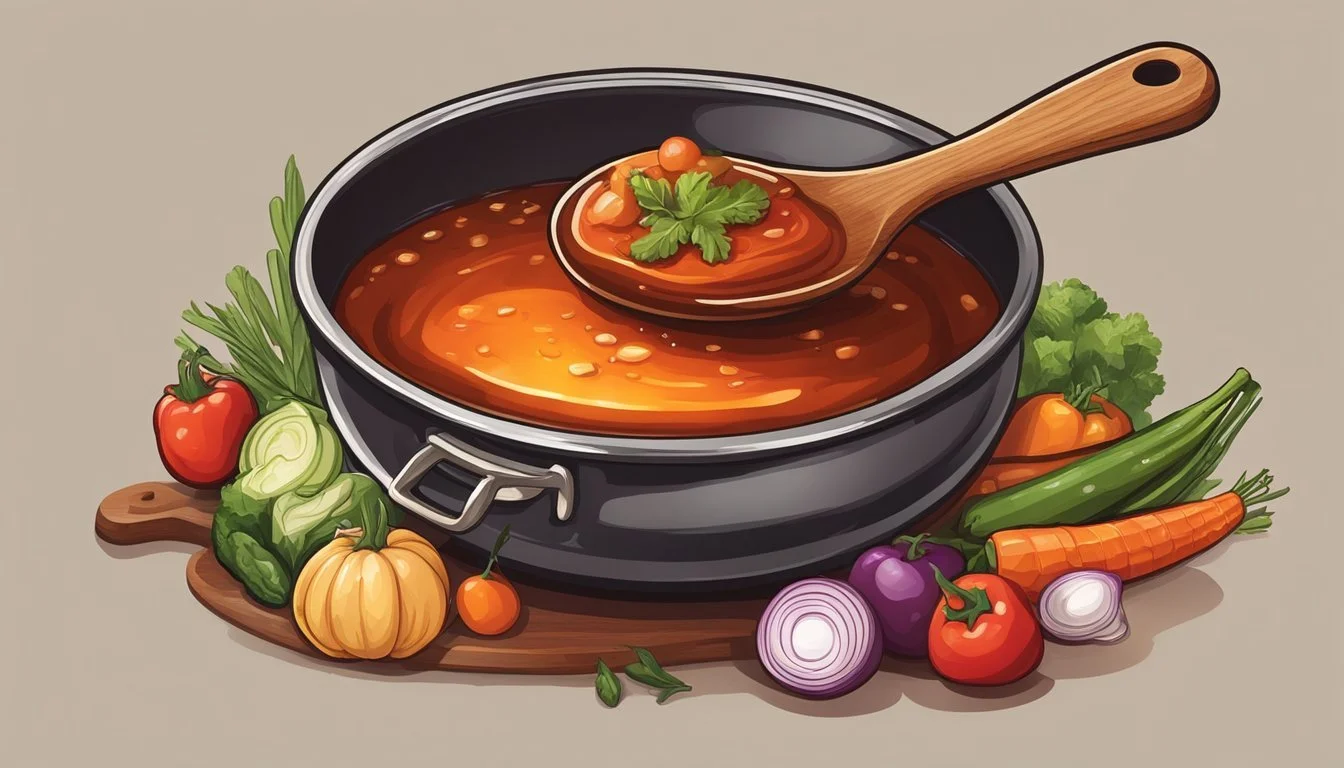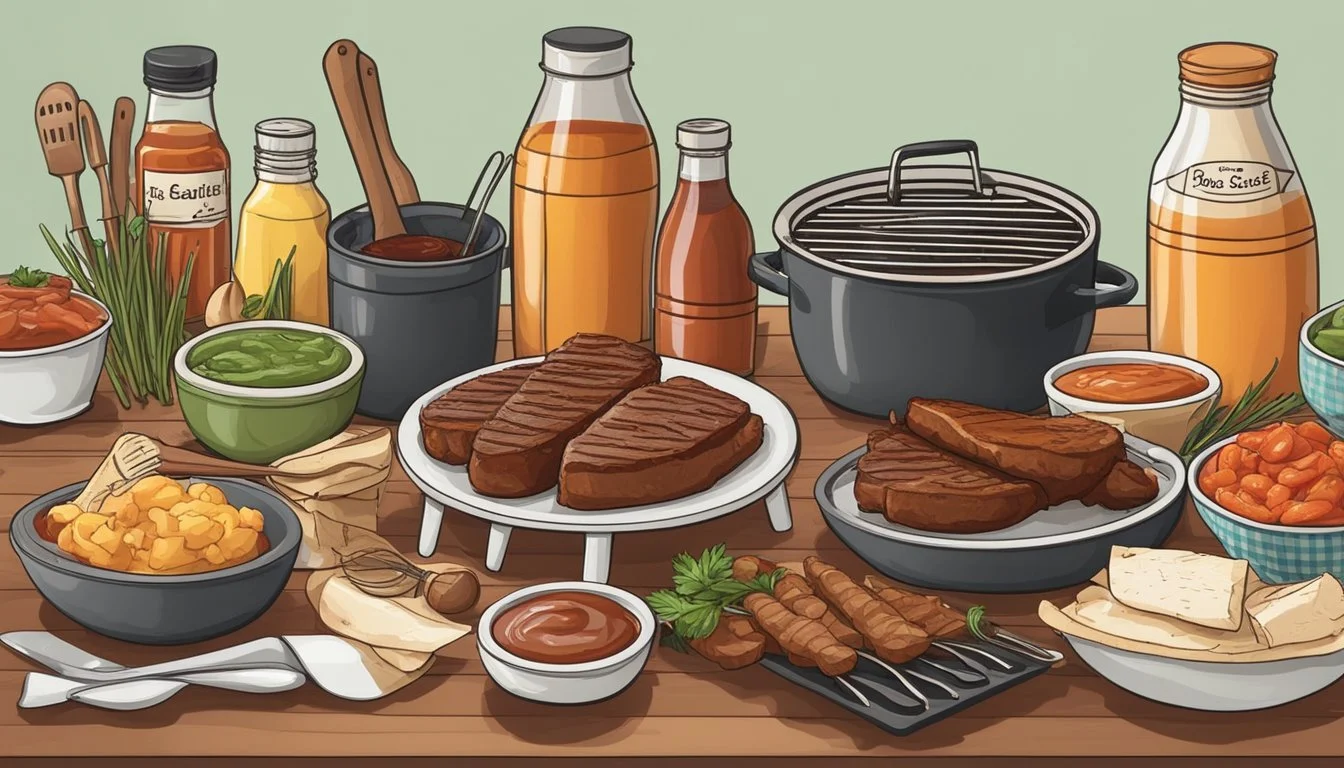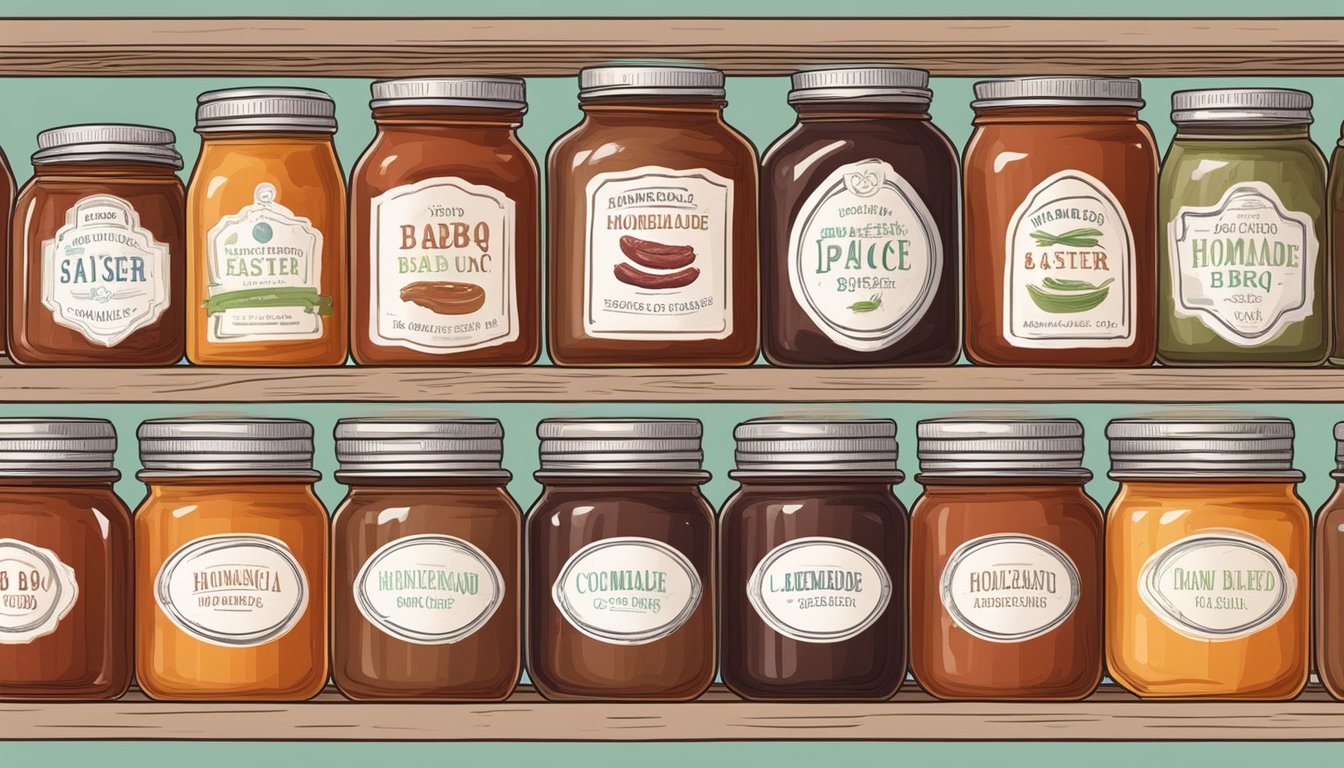Easter BBQ Sauces
Homemade Recipes to Elevate Your Holiday Cookout
Easter celebrations often bring to mind images of egg hunts and Sunday brunches, but for those looking to step outside the traditional fare, an Easter cookout adds a lively twist to the holiday. Grilling enthusiasts and food aficionados can agree that the cornerstone of any successful barbecue is a collection of sumptuous sauces that enhance and complement the flavors of the grilled meats (What wine goes well with grilled meats?) and vegetables. Homemade BBQ sauce recipes offer a personalized touch to Easter meals, creating an opportunity for cooks to showcase their culinary skills.
Crafting homemade BBQ sauces allows cooks to blend a variety of flavors from sweet to tangy to spicy, ensuring there is something to suit every palate at the Easter cookout. The sauces can be specifically tailored to match the profile of the dishes being served, whether it be a classic smoked ham or a less traditional barbecued lamb shoulder. The versatility of a well-made BBQ sauce can harmonize with the smokiness of the grill and the freshness of springtime ingredients, elevating the cookout to an event to remember.
As families and friends gather around the grill this Easter, the embrace of homemade recipes promises a unique and memorable culinary experience. The creation of homemade BBQ sauce becomes more than just a condiment—it's a central element of the celebration, infused with the cook’s own choice of herbs, spices, and other secret ingredients. This attention to detail and customization guarantees that the Easter BBQ will not only nurture the body but also delight the taste buds of all who attend.
The Basics of Homemade BBQ Sauce
Creating a homemade BBQ sauce allows for full control over flavor and ingredients, resulting in a condiment that can be sweet, tangy, or spicy to suit any palate. Let's explore the core components and the foundational types of BBQ sauce.
Understanding BBQ Sauce Ingredients
At its core, a BBQ sauce typically begins with a base such as ketchup or vinegar, providing the basic structure for the sauce. To this, a variety of ingredients are added to achieve different flavors. Common sweeteners like molasses, brown sugar, or honey are used to give the sauce its signature sweet touch. To create complexity and depth, a balance of sweet and tangy comes from additions such as apple cider vinegar or mustard. Bringing in spicy elements, one can incorporate chili flakes, hot sauce, or black pepper. The smoky flavor is often achieved with smoked paprika or liquid smoke.
Key Ingredients:
Base: Ketchup, Vinegar
Sweeteners: Molasses, Brown Sugar, Honey
Tanginess: Apple cider vinegar, Mustard
Spiciness: Chili flakes, Hot sauce, Black pepper
Smokiness: Smoked paprika, Liquid smoke
A perfect homemade BBQ sauce is one that balances these components to create a harmonious blend that complements the dish it accompanies.
The Five Fundamental Types of BBQ Sauces
BBQ sauces can be categorized into five fundamental types, each distinct in flavor and regional origin:
Tomato-based: Rich and thick, often starting with ketchup or tomato sauce, sweetened with sugars, and including a vinegar tang.
Vinegar-based: Thinner and more acidic, this type prominently features vinegar with a spicy kick, common in Carolina BBQ.
Mustard-based: Known in South Carolina, it combines mustard with sweetness and tanginess for a vibrant and bold flavor.
Mayonnaise-based: Primarily seen in Alabama, it offers a creamy alternative with a tart and unique taste.
Fruit-based: Utilizes fruit purees or jams to introduce a natural sweetness and varying degrees of tanginess, often found in gourmet recipes.
Each type provides a different canvas upon which additional flavors can be layered, creating endless variations for any Easter BBQ cookout.
Creating the Perfect BBQ Sauce Texture
The texture of BBQ sauce is pivotal, as it impacts both the flavor delivery and the sauce's adherence to food. Mastering thickness and consistency requires understanding the cooking techniques and ingredients that interact to form the final product.
Balancing Thickness and Consistency
In creating the perfect BBQ sauce texture, one must balance thickening agents and cooking times. Cornstarch is a common thickener, added in slurry form—mixed with an equal part of water—to prevent clumping. Achieving a desirable consistency involves simmering, a process where the sauce gently bubbles, allowing water to evaporate and flavors to concentrate without burning.
Key points:
Start with a moderate amount of thickener; additions can always be made.
Regular stirring while simmering prevents the sauce from sticking and burning.
Tips for Reducing or Thickening Sauce
For Reduction:
Simmering: Allow the sauce to simmer uncovered; this encourages evaporation.
Duration: A longer simmer results in a thicker sauce; typically, 20-30 minutes is sufficient but depends on initial volume.
For Thickening:
Cornstarch: Introduce a cornstarch slurry into the simmering sauce to achieve desired thickness.
Adjustments: If the sauce becomes too thick, add water or another liquid base in small increments.
Best Practices:
Simmer over low to medium heat to avoid sauce splatter and over-thickening.
Stir frequently to avoid uneven thickness and to incorporate ingredients uniformly.
By adhering strictly to these methods, one ensures that the texture of their BBQ sauce is ideal for their Easter cookout.
Flavor Profiles and Variations
When crafting homemade BBQ sauces for Easter, understanding and selecting from a spectrum of flavor profiles can elevate the cookout experience. Embrace the creativity that comes with tailoring combinations of sweet, savory, smoky, and spicy elements to suit individual tastes and complement a variety of meats.
Sweet and Savory Combos
The interplay between sweet and savory elements brings a harmonious balance to BBQ sauce. A foundational sweet component might include honey or brown sugar, which, when melded with savory Worcestershire sauce or tomato paste, creates a well-rounded flavor. The inclusion of onion powder and garlic powder adds depth, while a hint of apple cider vinegar provides a contrasting tanginess.
Key Ingredients: Honey, Brown Sugar, Tomato Paste, Worcestershire Sauce, Onion Powder, Garlic Powder, Apple Cider Vinegar
Flavor Profile: Balanced, Rich, Tangy
Smoky and Spiced Mixes
For a truly robust sauce, elements like smoked paprika, chipotle, or a dash of liquid smoke can impart the quintessential BBQ smokiness. This smoky foundation pairs exceptionally well with spice - think cayenne or black pepper - to create a flavor that stands up to the boldness of grilled meats.
Key Ingredients: Smoked Paprika, Chipotle, Liquid Smoke, Cayenne Pepper, Black Pepper
Flavor Profile: Bold, Deep, With a Kick
Customizing with Unique Ingredients
The art of BBQ sauce creation lies in its versatility. Additions like blueberries for a fruity twist or the incorporation of Tabasco sauce for a more piquant edge can make a sauce unique. Experimenting with less conventional ingredients allows for a custom sauce that can become the talk of the Easter cookout.
Unique Additions: Fruit (e.g., Blueberries), Hot Sauces (e.g., Tabasco)
Custom Flavor Profile: Innovative, Personal, Unexpected
Barbecue Sauces for Different Proteins
Creating the perfect BBQ sauce for different types of meat is critical for enhancing flavor and complementing each protein's unique qualities.
Beef-Friendly BBQ Sauce Options
For beef, a robust sauce with a hint of sweetness suits the strong flavors of steak, burgers, and ribs. A tomato-based sauce, thickened with molasses and brown sugar, can stand up to the bold taste of grilled steak. Additionally, a hint of smoky flavor is excellent for beef ribs, achieved using smoked paprika or liquid smoke.
Perfect Pork BBQ Sauces
Pork demands a sauce that balances sweetness with acidity, which can perfectly complement pulled pork sandwiches and ham. A mixture of apple cider vinegar with a splash of maple syrup provides the necessary tang for pulled pork, while a touch of mustard can add complexity to a sauce used on ham.
Chicken and Poultry Sauce Selections
When it comes to chicken, it's best to opt for a lighter, more savory sauce to enhance but not overpower the meat. For grilled chicken and chicken tenders, a sauce that includes lemon juice or white vinegar mixed with honey offers a refreshing zest. For chicken wings or pulled chicken, incorporating a touch of garlic and onion powder will provide an extra layer of flavor.
Cooking Techniques and Application Tips
When it comes to BBQ sauces, the way they are applied in the cooking process can enhance the flavors of the meats. It is important to understand when and how to use your homemade Easter BBQ sauce for grilling, marinating, and basting.
Grilling with BBQ Sauce
To achieve the best results, one should brush BBQ sauce on the meat during the last few minutes of grilling. This prevents the sauce from burning, as many sauces contain sugar that can char easily. Grilling meats like a smoked lamb shoulder at a higher temperature initially helps caramelize the skin, while a finishing touch of sauce adds a savory glaze.
Method: Brush on sauce during final 5-10 minutes
Temperature: Grill hot first, apply sauce last
Marinating Meats with Your Sauce
Marinating allows meats to absorb the rich flavors of the BBQ sauce, tenderizing them and enhancing their taste. Meat can be marinated in a slow cooker using a BBQ sauce mixture or in the refrigerator before grilling. Meat like steak or pork benefits greatly from at least a few hours in a flavorful marinade.
Duration: Minimum 2 hours to overnight
Tools: Refrigerator or slow cooker for even saturation
Basting for Flavorful Crusts
Basting involves periodically coating the meat with sauce to form a flavorful crust. It's particularly effective for creating a layer of taste that complements the marinade. Basting is a dynamic process that builds up the sauce's flavor profile during cooking.
Technique: Apply sauce at intervals throughout cooking
Tool: Basting brush for even application
Serving and Pairing Suggestions
The right accompaniments can elevate a simple BBQ dish to a memorable feast. When it comes to serving and pairing, consider how the taste, texture, and flavor of your sides will complement the smoky richness of barbecued meats (What wine goes well with barbecued meats?) and the tangy sweetness of your homemade sauces.
Side Dishes That Complement BBQ
An array of side dishes turns a barbecue from a simple meal into a spread with something for everyone.
Salads: A crisp green salad or a tangy coleslaw can cut through the richness of the BBQ and cleanse the palate.
Beans: Baked beans, seasoned with similar spices to those in your BBQ sauce, provide a hearty side that holds its own.
Fries: Serve a side of fries sprinkled with herbs and sea salt for a crowd-pleasing favorite.
Cornbread: Soft, buttery cornbread is a classic go-to for sopping up every last bit of sauce.
BBQ Sauce Beyond the Grill
BBQ sauce need not be reserved solely for grilling. This versatile condiment can enhance many other dishes.
Sandwiches and Sliders: A smoky BBQ sauce can transform pulled pork or chicken sandwiches into something special.
Type Meat Choice BBQ Sauce Type Sandwich Pulled Pork Sweet and Tangy Slider Brisket Rich and Smoky
Pizza and Quesadillas: Adding a layer of BBQ sauce brings a new flavor profile to these favorites.
Dish Topping Suggestion BBQ Sauce Note Pizza Grilled chicken, red onion Use as a base sauce Quesadilla Cheese, black beans Spread inside before grilling
Burgers and Dips: Elevate a burger with a generous helping of sauce, or mix BBQ sauce into a dip for a quick appetizer.
Preservation and Storage of BBQ Sauces
Proper storage techniques are vital for maintaining the quality and extending the shelf life of homemade barbecue sauces. Careful preservation ensures that sauces retain their intended flavor profile and remain safe for consumption over time.
Keeping Sauces Fresh in the Refrigerator
Homemade barbecue sauces should be stored in the refrigerator to maintain freshness. An airtight container or mason jar with a tight-fitting lid is ideal to prevent contamination and preserve taste. The sauce can generally be kept for up to 2 weeks when refrigerated immediately after cooling. To track its freshness, label the container with the date of preparation.
Container: Airtight (mason jar preferred)
Shelf life: Up to 2 weeks
Label: Date of preparation
Canning and Bottling for Long-Term Storage
For those planning to keep homemade sauces for extended periods, canning and bottling are recommended methods. It is essential to use sterilized mason jars and follow proper canning protocols to prevent bacterial growth. Once sealed, the bottled sauces can be stored in a cool, dark place and typically remain good for 6 to 9 months. If signs of spoilage are present, they should not be consumed.
Sterilization: Required for jars and lids
Storage: Cool, dark place
Shelf life: 6 to 9 months
Spoilage: Do not consume if present
Healthier BBQ Sauce Alternatives
Crafting healthier BBQ sauce alternatives can transform a traditional cookout into a more health-conscious affair. By focusing on reducing sugar and sodium content and utilizing natural sweeteners and spices, one can ensure a savory blend that complements any Easter BBQ without compromising on wellness.
Reducing Sugar and Sodium
When creating healthier BBQ sauce options, sugar and sodium levels are the first considerations. A significant reduction can be achieved by:
Opting for low-sodium soy sauce or tamari as alternatives to regular soy sauce.
Diluting sauces with water or apple cider vinegar to lower the concentration of sodium per serving.
Ingredient Substitute Benefit Table Salt Herbs, Spices, or Low-Sodium Salt Reduces sodium intake Granulated Sugar Smashed Fruits like Berries or Unsweetened Applesauce Lowers sugar content
By incorporating these alternatives, the BBQ sauce retains its robust flavor profile while significantly lowering calorie intake related to high sugar and sodium levels.
Using Natural Sweeteners and Spices
Natural sweeteners offer an excellent avenue to infuse sauces with the desired sweetness without heavily relying on refined sugars. They should utilize:
Honey or maple syrup, in modest amounts, can deliver a rich flavor and are more nutritious than white sugar.
Apple cider vinegar provides a tangy taste and works well to balance the sweetness brought by natural sweeteners.
The use of a variety of spices not only enhances the flavor but also provides potential health benefits. Spices such as:
Cinnamon and paprika can add depth without contributing to the sugar or sodium content.
Mustard adds tanginess and can create a complex flavor profile with minimal calories.
Through the judicious use of spices and natural sweeteners, one's barbecue sauce can become a highlight of the Easter cookout, offering both taste and health benefits.
Fun Twists on Traditional BBQ Sauces
Easter cookouts offer the perfect opportunity to showcase innovative takes on BBQ sauces. Here, explore how international flavors can elevate a traditional sauce, and discover how the combination of spicy and fruity elements can create a new taste experience.
International Flavors
Barbecue enthusiasts can amplify their sauce game by integrating international ingredients into traditional recipes. The incorporation of Worcestershire sauce provides a savory depth with its umami-rich profile. For a German twist, one might add mustard, creating a tangy kick that pairs exceptionally well with grilled sausages and burgers.
Japanese twist: Add soy sauce and a hint of wasabi for an umami and spicy kick.
Korean touch: Mix in Gochujang (fermented chili paste) for depth and a variety of spices to challenge the palate.
In each of these cases, the goal is to maintain the balance of the original BBQ flavor while introducing new, bold taste notes.
Spicy and Fruity Experimentations
A chef can further experiment with BBQ sauces by marrying spicy flavors with sweet and fruity undertones. Adding sriracha to a traditional sauce injects a vivid heat that is both contemporary and widely appealing.
Sauce Inspiration:
Sweet Heat: Combine honey or molasses with cayenne pepper for a sweet heat.
Citrus Spike: Blend in lemon juice to add a bright tartness to a spicy sauce, which can liven up any poultry or pork dish.
These adventurous combinations can revitalize classic recipes, turning them into memorable complements to the Easter feast. Each sauce evolution aims to provide a complex flavor profile that balances the spicy, the sweet, and the tangy.
DIY Barbecue Sauce Gift Ideas
When gifting homemade barbecue sauce, the presentation is nearly as important as the recipe. A well-packaged sauce can elevate it from a simple condiment to a thoughtful, seasonal gift, perfect for summer holidays or backyard barbecues.
Packaging Homemade Sauces for Presents
Materials Needed:
Mason jars or glass bottles with tight-sealing lids
Ribbons or twine
Fabric circles for jar covers
Wax paper or parchment circles to sit between the sauce and the fabric cover
Steps:
Ensure mason jars or bottles are sterilized.
After preparing the homemade bbq sauce recipe, cool it to room temperature.
Using a canning funnel, pour the sauce into jars, leaving some headspace.
If using fabric, place wax paper over the jar opening before securing the fabric with the jar ring.
Decorate with ribbons or twine around the neck of the jar.
Creative Labeling and Presentation Tips
Label Ideas:
Use a label maker for a clean, professional look.
Handwrite labels for a personal touch, using tags and a fine-point permanent marker.
Print custom labels to include the recipe, date made, and best by date.
Presentation Suggestions:
Attach a mini basting brush or wooden spoon to the jar.
Include a recipe card for the bbq sauce or suggested uses.
Place the jar in a small basket with other grilling items as part of a larger gift.
Reminder: Always inform the recipient of the ingredients to account for potential allergies.
Planning Your Easter Cookout Menu
When planning an Easter cookout menu, incorporating homemade BBQ sauce can elevate classic dishes with a personal touch. A thoughtful selection of meats, sides, and sauces ensures a varied and appealing spread for family and friends gathering to celebrate.
Meats to Grill:
Lamb: An Easter staple that pairs beautifully with a rosemary-infused BBQ sauce.
Ham: Opt for a honey-glazed smoked ham for a mix of sweet and smoky flavors. (What wine goes well with smoky flavors?)
Pork Belly (What wine goes well with pork belly?) : Amp up the menu with crispy smoked pork belly.
Homemade BBQ Sauce Variations:
Sweet: A honey-based sauce complements ham and pork.
Tangy: A vinegar and mustard sauce works well with lamb.
Spicy: Add a kick to any meat with a chipotle or cayenne pepper sauce.
Side Dishes:
Grilled vegetables
Potato salad
Coleslaw
For Leftovers: Ensure there are extra sauces and sides. Leftover grilled meats make delicious sandwiches or salads for next-day meals.
Remember to consider dietary preferences and allergies. Offer vegetarian options like grilled portobello mushrooms (What wine goes well with grilled portobello mushrooms?) or veggie skewers. Homemade sauces are adaptable; reserve some without allergens like gluten or nuts so everyone can enjoy a flavorful experience.
Presentation matters. Serve sauces in clear labeled jars and arrange dishes attractively. Good planning makes for unforgettable Easter cookouts, where the homemade BBQ sauce becomes the highlight. With this approach, hosts provide not just a meal, but also an experience.










